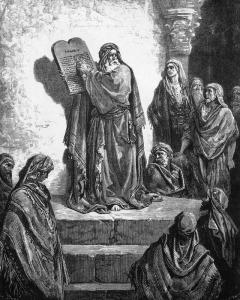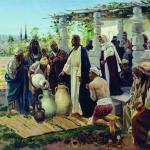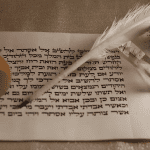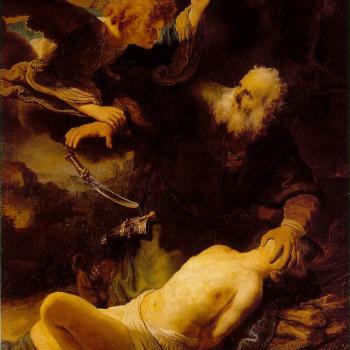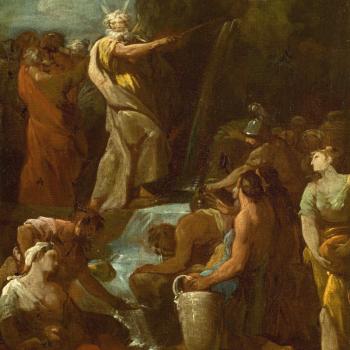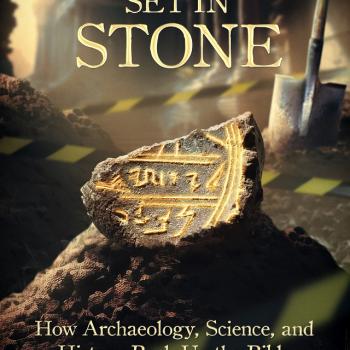I will be drawing heavily from an article written by the eminent Bible scholar and historian Edwin M. Yamauchi, entitled, “The Archaeological Background of Ezra,” (1).
Cyrus the Great (c. 590 or 580 B.C.- c. 529 B.C.) (2) was the founder of the Persian Empire, and reigned as king from 559-530, according to Yamauchi. Notably, during his reign, Babylon was conquered, in 539 B.C. God referred to him as follows:
Isaiah 44:28 (RSV) who says of Cyrus, ‘He is my shepherd, and he shall fulfil all my purpose’; saying of Jerusalem, ‘She shall be built,’ and of the temple, ‘Your foundation shall be laid.'” (cf. Isa. 45:1: “his anointed”)
The prophet Daniel was in Babylon when Cyrus conquered it (Dan. 1:21; 6:28; 10:1). The Jewish historian Josephus (c. 37-100 A.D.) (3) wrote about Cyrus and his key role in the rebuilding of the Jewish temple:
God . . . stirred up the mind of Cyrus, and made him write this throughout all Asia: “Thus saith Cyrus the king: Since God Almighty hath appointed me to be king of the habitable earth, I believe that he is that God which the nation of the Israelites worship; for indeed he foretold my name by the prophets, and that I should build him a house at Jerusalem, in the country of Judea.”
This was known to Cyrus by his reading the book which Isaiah left behind him of his prophecies; for this prophet said that God had spoken thus to him in a secret vision: “My will is, that Cyrus, whom I have appointed to be king over many and great nations, send back my people to their own land, and build my temple.” [see Isa. 44:28; 45:1-5] This was foretold by Isaiah one hundred and forty years before the temple was demolished. Accordingly, when Cyrus read this, and admired the Divine power, an earnest desire and ambition seized upon him to fulfill what was so written; so he called for the most eminent Jews that were in Babylon, and said to them, that he gave them leave to go back to their own country, and to rebuild their city Jerusalem, and the temple of God, for that he would be their assistant, and that he would write to the rulers and governors that were in the neighborhood of their country of Judea, that they should contribute to them gold and silver for the building of the temple, and besides that, beasts for their sacrifices. (4)
[Cyrus declared] that the temple should be built in Jerusalem; and the altar in height threescore cubits, and its breadth of the same, with three edifices of polished stone, and one edifice of stone of their own country; and he ordained that the expenses of it should be paid out of the king’s revenue. He also commanded that the vessels which Nebuchadnezzar had pillaged [out of the temple], and had carried to Babylon, should be restored to the people of Jerusalem; and that the care of these things should belong to Sanabassar, the governor and president of Syria and Phoenicia, and his associates, that they may not meddle with that place, but may permit the servants of God, the Jews and their rulers, to build the temple. He also ordained that they should assist them in the work; and that they should pay to the Jews, out of the tribute of the country where they were governors, on account of the sacrifices, bulls, and rams, and lambs, and kids of the goats, and fine flour, and oil, and wine, and all other things that the priests should suggest to them; . . . (5)
Cyrus (due, no doubt, to the many Jews residing in his country) was familiar with the book of Isaiah. Compare this to what the Bible records:
Ezra 1:1-4 In the first year of Cyrus king of Persia, that the word of the LORD by the mouth of Jeremiah might be accomplished, the LORD stirred up the spirit of Cyrus king of Persia so that he made a proclamation throughout all his kingdom and also put it in writing: “Thus says Cyrus king of Persia: The LORD, the God of heaven, has given me all the kingdoms of the earth, and he has charged me to build him a house at Jerusalem, which is in Judah. Whoever is among you of all his people, may his God be with him, and let him go up to Jerusalem, which is in Judah, and rebuild the house of the LORD, the God of Israel — he is the God who is in Jerusalem; and let each survivor, in whatever place he sojourns, be assisted by the men of his place with silver and gold, with goods and with beasts, besides freewill offerings for the house of God which is in Jerusalem.” (cf. 6:1-5)
We know from the Greek historian Herodotus (c. 484-430-420 B.C.) (6) that King Darius the Great (550-486; r. 522-486) (7) and Xerxes the Great (c. 519-465; r. 486-465) (8) — by analogy — paid close attention to Greek prophecies and oracles, as well:
Mardonios meanwhile had been wintering in Thessaly. From thence he sent round a man, a native of Europos, whose name was Mys, to the various Oracles, charging him to go everywhere to consult, wherever they were permitted to make trial of the Oracles. (9)
He [Mardonios] summoned therefore the commanders of the divisions and the generals of those Hellenes who were with him, and asked whether they knew of any oracle regarding the Persians, which said that they should be destroyed in Hellas; and when those summoned to council were silent, some not knowing the oracles and others knowing them but not esteeming it safe to speak, Mardonios himself said: “Since then ye either know nothing or do not venture to speak, I will tell you, since I know very well. There is an oracle saying that the Persians are destined when they come to Hellas to plunder the temple at Delphi, and having plundered it to perish every one of them. We therefore, just because we know this, will not go to that temple nor will we attempt to plunder it; and for this cause we shall not perish. So many of you therefore as chance to wish well to the Persians, have joy so far as regards this matter, and be assured that we shall overcome the Hellenes.” (10)
Yamauchi also states that Cambyses II (r. 529-522 B.C.) (11), the successor of Cyrus, “paid close heed . . . to Egyptian oracles.” (12) Thus, Cyrus heeding Jewish prophecies, while in close proximity to many Jews, shouldn’t surprise us at all. The Bible is confirmed yet again; in this instance, to what we know from the secular history of Persian kings. Ezra’s statement, “In the first year of Cyrus king of Persia,” means, according to Yamauchi, “the first regnal year of Cyrus, beginning in Nisan 538, after his capture of Babylon in October 539. During these same months following the capture of Babylon, cuneiform texts record the Persian king’s benefactions to Mesopotamian sanctuaries.” (13)
Ezra 1:1-4 was in Hebrew, but its parallel, 6:1-5, was in Aramaic, and the “scroll” it came from was found “in Ecbatana [aka Hamadan], the capital which is in the province of Media” (6:2). Roland de Vaux observes:
Now we know that it was the custom of the Persian sovereigns to Winter in Babylon and depart in the summer to . . . Ecbatana . . . A forger operating in Palestine without the information which we possess could hardly have been so accurate. (14)
Yamauchi notes that “The proclamation in Hebrew of Cyrus’s decree and its recording in Aramaic for the repositories is entirely in accord with Persian customs.” (15) He provides further corroboration of the various Persian decrees in Ezra:
In a recent dissertation under A. Millard, Hensley has examined the seven official documents in Ezra (1:2-4; 4:11-16; 4:17-22; 5:7-17; 6:2b-5; 6:6-12; 7:12-16) in the light of thirty-two contemporary Persian documents and letters. He concludes that “linguistically, stylistically, and historically the ED (Ezra Documents) correspond perfectly to the non-Biblical documents of the Achaemenid period” (C. Hensley, “The Official Persian Documents in the Book of Ezra” [Ph.D. diss., University of Liverpool, 1977]. p. 233). (16)
Ezra 1:2 reports Cyrus saying, “The LORD, the God of heaven, has given me all the kingdoms of the earth.” An inscription citing Cyrus from Ur, reads, “The great gods have delivered all the lands into my hand.” (17)
Archaeologists working at Uruk and Ur note that Cyrus made restorations in temples there as well. (18) A general picture of his religious magnanimity is well-attested in the Bible and outside of it. In this regard he was followed by King Darius the Great:
The Gadatas Inscription of Darius I to a governor in Ionia in western Turkey reveals Darius’s concern for the priests of Apollo at a temple near Magnesia. (19)
But in that you are causing my intention on behalf of the gods to be forgotten, I shall give you, if you do not change your course, cause to know that I am angered; for you have levied tribute from the sacred gardeners of Apollo, and ordered them to dig unhallowed soil, not knowing my feeling towards the god, who spoke all truth to the Persians . . . (20)
Yamauchi continues his documenting of the extraordinary Persian religious tolerance:
Extrabiblical evidence, . . . makes it quite clear that it was a consistent policy of Persian kings to help restore sanctuaries in their empire. . . .
Cyrus repaired the Eanna temple at Uruk and the Enunmah at Ur. Cambyses gave funds for the temple at Sais in Egypt. (21) The temple of Amon at Hibis in the Khargah Oasis, . . . was rebuilt from top to bottom by order of Darius. (22) Darius also restored the temple of Ptah in Egypt. (23) (24)
After interruptions due to opposition (Ezra 4:4-5, 24), the rebuilding of the temple was commenced again in the second year of the reign of Darius the Great in 521 or 520 B.C. (4:24; Hag. 1:1, 14-15) and was finished in his sixth year: 517 or 516 B.C. (Ezra 6:15).
Ezra 7:7-8 And there went up also to Jerusalem, in the seventh year of Artaxerxes the king, some of the people of Israel, and some of the priests and Levites, the singers and gatekeepers, and the temple servants. And he came to Jerusalem in the fifth month, which was in the seventh year of the king;
Ezra 7:25-26 [from Artaxerxes I (25) ]”And you, Ezra, according to the wisdom of your God which is in your hand, appoint magistrates and judges who may judge all the people in the province Beyond the River, all such as know the laws of your God; and those who do not know them, you shall teach. Whoever will not obey the law of your God and the law of the king, let judgment be strictly executed upon him, whether for death or for banishment or for confiscation of his goods or for imprisonment.”
The reign of Artaxerxes I began in 465 B.C., so this event can be precisely dated to 458 B.C. Yamauchi comments (26) on this unusual commissioning of Ezra by a Persian king,
The fact that Artaxerxes I commissioned Ezra the scribe to administer the Law to his people has troubled some critics. But this fits in perfectly with Persian policy. A very close parallel is a similar commission given by Darius I to Udjahorresenet, an Egyptian priest and scholar. Darius commanded the codification of the Egyptian laws in Demotic and Aramaic by the chief men of Egypt – a task which took from 518 to 503 B.C. On the reverse side of the Demotic Chronicle, Darius ordered “that the wise men be assembled . . . from among the warriors, the priests and the scribes of Egypt so that they may set down in writing the ancient laws of Egypt.” (27)
R. N. Frye makes similar observations,
Darius was actively concerned not only with his own “imperial” laws, to be promulgated throughout the empire, but also with the local laws and traditional practices in various provinces . . . Darius wrote to his satrap in Egypt Aryandes to collect the wise men of the realm to make a new code of laws. Although the work was not finished before his death, the successors of Darius continued to be interested in the codification of the laws of their subject peoples. It is in this light that one must understand the efforts of Ezra (7, 11) and Nehemiah (8,1) to codify the Mosaic law, which was not accomplished until the reign of Artaxerxes I. (28)
It is clearly the Pentateuch, or Torah (first five books of the Old Testament) that Ezra read to the crowd (Neh. 8:2-15) for five hours. Bruce K. Waltke, writes:
Finally, the Pentateuch itself must be older than the fifth century. If the scribal scholars of the second Jewish commonwealth found it necessary to modernize the Pentateuch to make it intelligible to the people (cf. Neh. 8) in the fifty century, then obviously the original Pentateuch antedates this period by many years. (29)
In June 2020, the announcement of a discovery in Jerusalem related to the Ezra-Nehemiah period of return to Jerusalem was made:
Excavators uncovered a seal and a bullae – a seal impression use to sign documents or containers during ancient times – in the Givati Parking Lot Excavation of the City of David in Jerusalem. These two artifacts were found next to the rubble of a structure that was destroyed during the 6th century BC by the Babylonians. . . .
“The finding of the stamp and seal impression in the City of David indicates that despite the city’s dire situation after the destruction, efforts were made to restore the administrative authorities to normal, and its residents continued to partly use the structures that were destroyed,” explained Prof. [Yuval] Gadot and Dr. [Yiftah] Shalev. . . .
“Discovering the new findings on the western slope of the City of David adds much information about the city’s structure during the period of the Return to Zion, a period we knew about mainly from Biblical literature (the books of Ezra and Nehemiah),” the researchers said. “The paucity of the findings from this period made it difficult to understand the status and extent of the city. The findings from the Givati Parking Lot Excavation shed light on the renewal of the local administration, in a location similar to the one that existed before the destruction of the First Temple, about 100 years prior.” (30)
According to Dr. Ido Koch of the Department of Archaeology and Ancient Near Eastern Cultures at Tel Aviv University, only about ten artifacts of this style have been found in Israel, in places such as Ein Gedi and Jerusalem, which appear to have been in use during the Persian period. Another bulla of this style, also from the Persian period, was discovered in excavations carried out by Dr. Eilat Mazar on the eastern slope of the City of David. (31)
These two artifacts from the Persian Period are evidence that the pace of the rebuilding of Israelite society in Jerusalem was as described in Ezra and Nehemiah. These books describe successful efforts of the returning Israelites to restore some measure of Jewish society and administrative governance in Jerusalem, within the context of a dominating foreign power. (32)
FOOTNOTES
1) Edwin M. Yamauchi, “The Archaeological Background of Ezra,” Bibliotheca Sacra 137 (July-September 1980), 195-211. Dr. Yamauchi (b. 1937) is Professor Emeritus of History at Miami University, (Oxford, Ohio), where he taught from 1969 until 2005. He studied Mandaean Gnostic texts as part of his Ph.D. dissertation at Brandeis University, and learned 22 different languages, including Hebrew, Aramaic, Akkadian, Ugaritic, Arabic, Syriac, and Coptic. His areas of expertise include: Ancient History, Old Testament, New Testament, Early Church History, Gnosticism, and Biblical Archaeology. Dr. Yamauchi has published 80 essays in 37 scholarly journals, and numerous books and book chapters, including Persia and the Bible (Grand Rapids, Michigan: Baker Academic, 1997).
2) [Cyrus the Great info.]
3) [Josephus info.]
4) Josephus, The Antiquities of the Jews, Book XI, ch. 1, secs. 1-2.
5) Josephus, ibid., Book XI, ch. 4, sec. 6)
6) [Herodotus info.]
7) [Darius the Great information]
8) [Xerxes the Great information]
9) Herodotus, Histories (translated by G. C. Macauley, 1904), Book VIII, 133. Mardonius (d. 479 B.C.) was one of the leading generals of and consultant to King Darius and Xerxes I.
10) Ibid., IX, 42.
11) [Cambyses II info.]
12) Yamauchi, 200.
13) Yamauchi, 201.
14) Roland de Vaux, The Bible and the Ancient Near East, translated by Damian McHugh (Garden City, New York: Doubleday & Co., 1971), 89.
15) Yamauchi, 208.
16) Yamauchi, 209.
17) Yamauchi, 201.
18) C. L. Woolley, Ur of the Chaldees (reprint ed., New York: W. W. Norton & Co., 1965), 205; C. L. Woolley and M. E. L. Mallowan, Ur Excavations IX: The Neo-Babylonian and Persian Periods (London: British Museum, 1962).
19) Yamauchi, 201-202.
20) Cited by A. Burn, Persia and the Greeks (New York: St. Martin’s Press, 1962), 114.
21) De Vaux, “The Decrees of Cyrus and Darius,” 71; A. Gardiner, Egypt of the Pharaohs (London: Oxford University Press, 1961), 366-67.
22) M. F. Gyles, Pharaonic Policies and Administration 663-323 B.C. (Chapel Hill, NC: University of North Carolina Press, 1959), 70; R. Parker, “Darius and His Egyptian Campaign,” American Journal of Semitic Languages 58 (1941): 373-77; G. Cameron, “Darius, Egypt and the ‘Lands Beyond the Sea,'” Journal of Near Eastern Studies 2 (1943): 307-13.
23) George Buchanan Gray, “The Foundation and Extension of the Persian Empire,” in The Cambridge Ancient History (Cambridge: At the University Press, 1939), 4:25: cf. de Vaux. The Bible and the Ancient Near East, 76.
24) Yamauchi, 202.
25) [Artaxerxes I info.]
26) Yamauchi, 205.
27) Gardiner, Egypt of the Pharaohs, 366-67.
28) R. N. Frye, “Institutions,” in Beitrage zur Achamenidengeschtchte, ed. G. Walser (Wiesbaden: Franz Steiner, 1972), 92.
29) Bruce K. Waltke, unpublished Harvard dissertation, “The Samaritan Pentateuch and the Text of the Old Testament,” included in New Perspectives on the Old Testament, ed. J. Barton Payne (Waco, Texas: Word Books, 1970), 234.
30) Emily Jones, “Israeli Archaeologists Find Ancient Artifacts from the Time of Ezra, Nehemiah,” CBN, June 30, 2020.
31) David Israel, “Archaeological Evidence Confirms Jerusalem’s Restoration Under Ezra and Nehemiah,” JewishPress.com, June 30, 2020.
32) John Metil, “Rare Artifacts Discovered from the Persian Period: Support Bible’s Ezra and Nehemiah,” Patterns of Evidence, December 11, 2020.
***
Practical Matters: Perhaps some of my 4,200+ free online articles (the most comprehensive “one-stop” Catholic apologetics site) or fifty-one books have helped you (by God’s grace) to decide to become Catholic or to return to the Church, or better understand some doctrines and why we believe them.
Or you may believe my work is worthy to support for the purpose of apologetics and evangelism in general. If so, please seriously consider a much-needed financial contribution. I’m always in need of more funds: especially monthly support. “The laborer is worthy of his wages” (1 Tim 5:18, NKJV). 1 December 2021 was my 20th anniversary as a full-time Catholic apologist, and February 2022 marked the 25th anniversary of my blog.
PayPal donations are the easiest: just send to my email address: apologistdave@gmail.com. You’ll see the term “Catholic Used Book Service”, which is my old side-business. To learn about the different methods of contributing, including 100% tax deduction, etc., see my page: About Catholic Apologist Dave Armstrong / Donation Information. Thanks a million from the bottom of my heart!
***
Photo credit: Ezra Reads the Law to the People (from illustrations for La Grande Bible de Tours, 1866), by Gustave Doré (1832-1883) [public domain / Wikimedia Commons]
***
Summary: I present several evidences from secular historical accounts & archaeology that back up the historical trustworthiness of the book of Ezra from the 5th century B.C.


